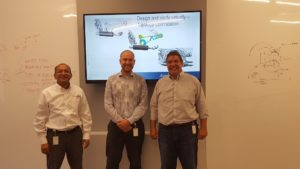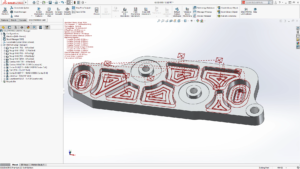![]() User-favorite SOLIDWORKS recently announced software updates to the frequently-used platform for the 2018 edition. With several big themes and myriad projects bundled into these updates, a quick overview isn’t enough to dive in to all that the industrious team behind the release has been up to; I recently headed to Boston to receive a full briefing directly from the team at the North American headquarters of parent company Dassault Systèmes, and so have more information right from the source to share on what we can expect.
User-favorite SOLIDWORKS recently announced software updates to the frequently-used platform for the 2018 edition. With several big themes and myriad projects bundled into these updates, a quick overview isn’t enough to dive in to all that the industrious team behind the release has been up to; I recently headed to Boston to receive a full briefing directly from the team at the North American headquarters of parent company Dassault Systèmes, and so have more information right from the source to share on what we can expect.
“Helping customers design and deliver mechatronics, helping customers work in and manage multi CAD environments, connect the entire enterprise, and work with additive and subtractive technologies,” Kishore Boyalakuntla, VP, Product Portfolio Management, Brand UX Leader, explained, are the themes key to SOLIDWORKS 2018 updates.
Integration in workflow is what I walked away with as the major takeaway, along with enhanced democratization of design, as this year the team behind SOLIDWORKS have taken great pains to carefully comb through features and tools that have proven to be most useful to their large and active user base.
- Dassault Systèmes North American HQ
- Gian Paolo Bassi
- (L-R) Kishore Boyalakuntla, Mark Rushton, Craig Therrien
Gian Paolo Bassi, CEO of SOLIDWORKS, told me, “SOLIDWORKS is known for CAD, for geometry, for being fast, efficient in geometry. There is a transformation to a complete portfolio, and platform thinking is our strategy. Our customers require very tight integration with the design phase.”
Working with subtractive and additive manufacturing technologies, users have become well attuned to what best helps them in creating their projects in the most efficient ways. Some of these tools have come from outside the direct SOLIDWORKS line and are now featuring in this platform as, new for 2018, technology from Simulia has come over to be leveraged inside SOLIDWORKS Simulation for Topology Study, Worldwide Director of Product Introduction Kurtis Anliker explained.
“This essentially works like SOLIDWORKS Simulation in terms of loads and constraints — I tell it I want the best strength-to-weight ratio, or I want stiffest, lightest part, or take 30% of mass away. We see this type of technology go directly to additive manufacturing,” he continued.
Additive is, though, at present a small percentage of their user base, with many parts designed to be stamped or milled. In theory, Anliker said, following the topology study, information will come back as a mesh model of a part that could then go directly into additive manufacturing; this theory is not a present reality, though, as cleanup in SOLIDWORKS CAD is required. Looking more toward offerings now available with focus on additive technologies, we discussed Mesh Modeling capabilities, new for this release. The 2018 updates handle mesh as native geometry, as Boyalakuntla underscored.
“This acts like a normal SOLIDWORKS thing, makes it easy for [users] to work with, bringing in to design so I need it to act like a normal SOLIDWORKS citizen, if you will,” he said. “Users want to be able to open this, reference this, use this, design around this, change this in design… What we find users want to do is take this and bring it into their SOLIDWORKS models; in 2018, it’s as simple as file open, mesh file. You can convert mesh regions directly into surfaces — planar, cylindrical, conical, spherical.”
File types including stl, obj, off, ply, ply2, amf, and 3mf are supported. This allows for work such as reverse engineering, recognizing faces for usable geometries, and mating back into assembly. The team “did a lot with user experience to make it work and act like any SOLIDWORKS thing,” Boyalakunlta said, “it just starts as a mesh.” Mesh in general, he noted, is part of “a huge way we see people moving forward in getting information in quickly and back out quickly in many forms.”
An increase in the number of tools ready to take on more tasks for additive manufacturing is part of a carefully measured move from SOLIDWORKS, as they work to ease users’ transition into more advanced technologies. Each member of the team I spoke to made it a point to note that they didn’t want customers to face “too big a leap” in facing a new process or design tool while also jumping into 3D printing. As Anliker pointed out, introducing more targeted topology tools working with mesh is a move toward inspiring confidence in users as they understand realizable and familiar processes and results, as a part designed for and created via additive means “will work like other parts I’ve manufactured, driven by a new source.”
He continued, “Topology gives stress results in mesh, we see the mesh model had same ballpark of stress results. Users should feel confident taking this new approach to additive. We think a lot of users will adopt new technology then explore new manufacturing methods from there with that introduction.”
I spoke as well with Mark Rushton, Product Portfolio Manager, whom I had met earlier this year at SOLIDWORKS World. He noted particular excitement about the prospects for the Topology Study in this release and its implications for design for additive manufacture (DfAM).
“DfAM is still something a lot of engineers are really new to. Software doing DfAM for you, almost, makes it a lot easier, makes design for production much more accessible,” Rushton said. “Like most, it’s down to the designer to understand the process. We have a lot in SOLIDWORKS for injection molding, added some in 2017 for 3D printing as well; this is the next natural progression to enable design for additive.”
Representing another step forward in his view was SOLIDWORKS’ recent joining up with America Makes, as Rushton said, “we’re keen to promote additive and really exploit the benefits, there’s a lot more we can do.” America Makes, for its part, recently celebrated its fifth birthday and has been working to enhance the standing of 3D printing and related technologies through work with a wide network of partners. Partnerships represent an important focus as well for SOLIDWORKS, as the company works with 3D printer manufacturers to “find common ground that suits everybody,” an increasing challenge in the varied intellectual property (IP) landscape emerging in additive manufacturing. Several familiar names are among the manufacturers SOLIDWORKS has been working with, including Stratasys, voxel8, Nano Dimension, and many others; a majority of 3D printers on the market today were themselves, the team noted, designed using this software.
Rushton echoed a familiar refrain in noting, “For additive to be successful it’s not going to be one company that’s going to make it happen, it’s going to be partnerships, software and hardware working together.”
SOLIDWORKS is looking to play into this collaborative field by working directly with manufacturers and users across a variety of technologies and experience levels, trying to keep on top of opportunities and engaging the industry as adoption rises.
“From my point of view, additive manufacturing can be now treated as another way to produce products, and I don’t think it has been in the past,” Rushton told me of the rise in real-world applications. “It has been a tool as part of the process, and is now at the stage where you can use it for tools and fixture design… It needs to be treated as another manufacturing process, not just something you do. Checking tools are a big way of doing that; you always need to check in manufacturing. I think additive should be the same; you don’t just 3D print something and hope for the best. There should be a way to check, and that’s really what we have with SOLIDWORKS 2018.”
Working with various file formats, data sources, and manufacturing technologies is allowing for more intelligent design via SOLIDWORKS, the team noted, and they are confident in their way forward in building upon earlier releases and enhancing features users have reacted positively toward. The professional capabilities for which many customers employ this software underlie a major focus: realizability.
“We place a lot of focus on design to manufacture; getting product out the door is really one of the most important things,” Anliker emphasized. “If you don’t have everything you need to get your product made and shipped, it doesn’t do you an good. You can have the best design that never gets to a customer.”
Among some of the tools he noted as being useful in getting the product built are:
- Tab & Slot Feature
- Drawing
- SOLIDWORKS MBD
- Inspection Add-in
“All of this is the environment our users love, the sum total that makes them so productive; that’s why they like SOLIDWORKS. It’s not any of these pieces, it’s the sum total, as a process to take all the way from design through manufacturing,” he concluded.
“There’s something very beautiful that’s captured here… what happens now is for additive and subtractive manufacturing we have this beautiful thing here with topology optimization, directly connect to manufacturing, IP goes with one click to the engineer — all impacts engineering design, management data tool connects all of it. 2018 represents an incredibly mature release.”
The evolution of the SOLIDWORKS portfolio can be traced across several factors, including flexibility in business model and use; change in product design; change in design methodologies; change in persona. Boyalakuntla walked me through some of these major evolutions as the platform has gown with its use and with advances in technological capability. Bassi additionally spoke to the ways in which not only the SOLIDWORKS platform, but manufacturing itself, has been evolving with the times.
“We are morphing, we are slowly modifying our path in the direction of providing our customers with a platform where at the end they can be more innovative. This is not only about speed, about efficiency, just-in-time is a concept of the 70s, of the 80s; we are not worried about time to market, we care about being right to market. This is a completely different way of thinking; we need to think about customer even before design, understand their wants and needs for products and services. This is becoming more and more difficult. Okay, we wanted to design faster, designing in 3D is accomplishing this goal, but the bar keeps raising, with innovation, with who brings more… Our customers need more innovation. We think that bringing to the next step of integration will bring more innovation and expanding the way computers can help our customers,” Bassi said of the growth momentum behind SOLIDWORKS.
“This is an exciting time for us. I think we’re at the beginning of a new era. 3D printing is creating new opportunities for society… Fablab offers democratization of innovative process as part of their mission. It’s in our mission as well. If you have to spend $100K that’s not really democratic. One of the foundations of SOLIDWORKS is to put this power into the hands of individuals, and over the years we have put the technology into three million pairs of hands.”
As SOLIDWORKS indeed makes its way to more and more users, it has become a mainstay in design across a variety of verticals. The team behind it are especially enthusiastic about and proud of the 2018 release. Boyalakuntla, expressive by nature, admitted that he is “a very biased source” and to take his opinions as that, but thinks heartily that “SOLIDWORKS is the best place to innovate” based on its breadth and depth.
“For ease of use, broad range of technologies, availability of talent pool coming in with SOLIDWORKS expertise, distribution channels, implementations they do — it’s a holistic thing, and holistically I believe SOLIDWORKS is the best place for companies to innovate; it’s not just time and money but the whole process that makes extra savings, best place. They tell us that. Customers thank us for visiting them, even when they’re upset about something, it’s a very kind conversation,” he told me.
“For the first time, there is this full story, full Design to Manufacturing, Distributed Data Management, IoT, Design to Analyst Simulation story.”
 For his part, CEO Bassi is focused on the way ahead. He noted that change is part of growth, and that SOLIDWORKS will continue to both grow and change as the offerings meet the challenges that lie ahead.
For his part, CEO Bassi is focused on the way ahead. He noted that change is part of growth, and that SOLIDWORKS will continue to both grow and change as the offerings meet the challenges that lie ahead.
“Some people consider software for manufacturing a static industry, I don’t see that at all,” Bassi told me.
“Mass production is tapering off, concentration in some geographic areas I think is becoming obsolete, because the market is changing, because of the power of technology and innovation, as it becomes more sustainable. Making all in one place and shipping all around doesn’t make sense. Fabricate what you need. New technologies are making this possible, and we are seeing a return to this type of thinking. In the past it had been a constraint and now it is a freedom in how we manufacture and produce things. It’s a good choice because we can more uniformly create wealth and enjoyment and people live where they want. We wanted to give this to everybody. This is happening, actually. You have seen the fablab, everyone goes in there and comes out with something done, this is pretty remarkable.”
SOLIDWORKS is making available more information about the 2018 release; for insights from the team I spoke to at the HQ, you can tune in on Tuesday, September 26th to their live launch event to hear more directly from Bassi, Anliker, and Boyalakuntla. You can find more details on new updates here and here from the team as well.
Join the discussion on this story and other 3D printing topics at 3DPrintBoard.com, or share your comments below.
[Photos: Sarah Goehrke / SOLIDWORKS images: Dassault Systèmes]
Subscribe to Our Email Newsletter
Stay up-to-date on all the latest news from the 3D printing industry and receive information and offers from third party vendors.
You May Also Like
US Army Corps of Engineers Taps Lincoln Electric & Eaton for Largest 3D Printed US Civil Works Part
The Soo Locks sit on the US-Canadian border, enabling maritime travel between Lake Superior and Lake Huron, from which ships can reach the rest of the Great Lakes. Crafts carrying...
Construction 3D Printing CEO Reflects on Being Female in Construction
Natalie Wadley, CEO of ChangeMaker3D, could hear the words of her daughter sitting next to her resounding in her head. “Mum, MUM, you’ve won!” Wadley had just won the prestigious...
Blue Laser-powered M600 3D Printer Launched by Meltio
Founded in 2019 as a joint venture between Additec and Sicnova, metal 3D printer OEM Meltio develops and manufactures high-performance and easy-to-use metal 3D printing solutions that use its patented wire-laser metal...
3D Printed Storage Tanks Cut Material Costs by 25%
In a previous article, “Concrete Dreams: Let’s Print Money, Not Houses,” we discussed how the spotlight on 3D printing homes might be misplaced. Bollards, pedestrian bridges, and concrete tanks could...







































